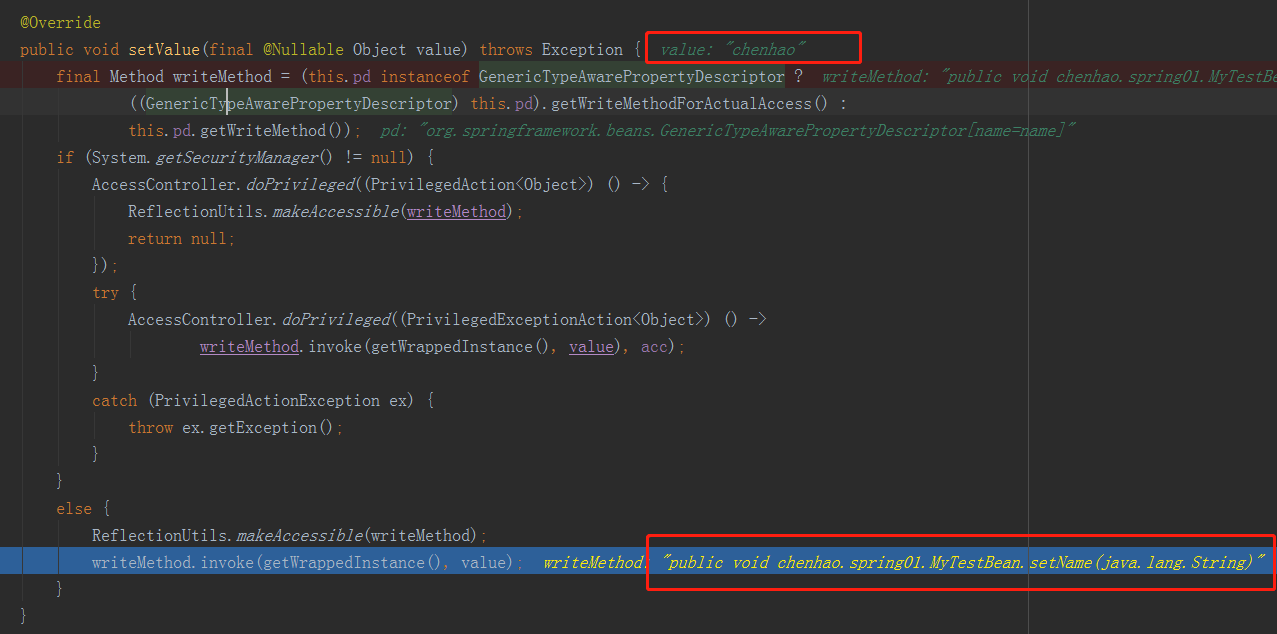正文:
doCreateBean()主要用于完成 bean 的创建和初始化工作,我们可以将其分为四个过程:
createBeanInstance()实例化 beanpopulateBean()属性填充- 循环依赖的处理
initializeBean()初始化 bean第一个过程实例化 bean在前面一篇博客中已经分析完了,这篇博客开始分析 属性填充,也就是
populateBean()
2
3
4
5
6
7
8
9
10
11
12
13
14
15
16
17
18
19
20
21
22
23
24
25
26
27
28
29
30
31
32
33
34
35
36
37
38
39
40
41
42
43
44
45
46
47
48
49
50
51
52
53
54
55
56
57
58
59
60
61
62
63
64
65
66
67
68
69
70
71
72
73
74
75
76
77
78
79
80
81
82
PropertyValues pvs = mbd.getPropertyValues();
if (bw == null) {
if (!pvs.isEmpty()) {
throw new BeanCreationException(
mbd.getResourceDescription(), beanName, "Cannot apply property values to null instance");
}
else {
// Skip property population phase for null instance.
return;
}
}
// Give any InstantiationAwareBeanPostProcessors the opportunity to modify the
// state of the bean before properties are set. This can be used, for example,
// to support styles of field injection.
boolean continueWithPropertyPopulation = true;
if (!mbd.isSynthetic() && hasInstantiationAwareBeanPostProcessors()) {
for (BeanPostProcessor bp : getBeanPostProcessors()) {
if (bp instanceof InstantiationAwareBeanPostProcessor) {
InstantiationAwareBeanPostProcessor ibp = (InstantiationAwareBeanPostProcessor) bp;
//返回值为是否继续填充bean
if (!ibp.postProcessAfterInstantiation(bw.getWrappedInstance(), beanName)) {
continueWithPropertyPopulation = false;
break;
}
}
}
}
//如果后处理器发出停止填充命令则终止后续的执行
if (!continueWithPropertyPopulation) {
return;
}
if (mbd.getResolvedAutowireMode() == RootBeanDefinition.AUTOWIRE_BY_NAME ||
mbd.getResolvedAutowireMode() == RootBeanDefinition.AUTOWIRE_BY_TYPE) {
MutablePropertyValues newPvs = new MutablePropertyValues(pvs);
// Add property values based on autowire by name if applicable.
//根据名称自动注入
if (mbd.getResolvedAutowireMode() == RootBeanDefinition.AUTOWIRE_BY_NAME) {
autowireByName(beanName, mbd, bw, newPvs);
}
// Add property values based on autowire by type if applicable.
//根据类型自动注入
if (mbd.getResolvedAutowireMode() == RootBeanDefinition.AUTOWIRE_BY_TYPE) {
autowireByType(beanName, mbd, bw, newPvs);
}
pvs = newPvs;
}
//后处理器已经初始化
boolean hasInstAwareBpps = hasInstantiationAwareBeanPostProcessors();
//需要依赖检查
boolean needsDepCheck = (mbd.getDependencyCheck() != RootBeanDefinition.DEPENDENCY_CHECK_NONE);
if (hasInstAwareBpps || needsDepCheck) {
PropertyDescriptor[] filteredPds = filterPropertyDescriptorsForDependencyCheck(bw, mbd.allowCaching);
if (hasInstAwareBpps) {
for (BeanPostProcessor bp : getBeanPostProcessors()) {
if (bp instanceof InstantiationAwareBeanPostProcessor) {
InstantiationAwareBeanPostProcessor ibp = (InstantiationAwareBeanPostProcessor) bp;
//对所有需要依赖检查的属性进行后处理
pvs = ibp.postProcessPropertyValues(pvs, filteredPds, bw.getWrappedInstance(), beanName);
if (pvs == null) {
return;
}
}
}
}
if (needsDepCheck) {
//依赖检查,对应depends-on属性,3.0已经弃用此属性
checkDependencies(beanName, mbd, filteredPds, pvs);
}
}
//将属性应用到bean中
//将所有ProtertyValues中的属性填充至BeanWrapper中。
applyPropertyValues(beanName, mbd, bw, pvs);
>}我们详细分析下populateBean的流程:
(1)首先进行属性是否为空的判断
(2)通过调用InstantiationAwareBeanPostProcessor的postProcessAfterInstantiation(bw.getWrappedInstance(), beanName)方法来控制程序是否继续进行属性填充
(3)根据注入类型(byName/byType)提取依赖的bean,并统一存入PropertyValues中
(4)应用InstantiationAwareBeanPostProcessor的postProcessPropertyValues(pvs, filteredPds, bw.getWrappedInstance(), beanName)方法,对属性获取完毕填充前的再次处理,典型的应用是RequiredAnnotationBeanPostProcesser类中对属性的验证
(5)将所有的PropertyValues中的属性填充至BeanWrapper中
上面步骤中有几个地方是我们比较感兴趣的,它们分别是依赖注入(autowireByName/autowireByType)以及属性填充,接下来进一步分析这几个功能的实现细节
1. 自动注入
Spring 会根据注入类型( byName / byType )的不同,调用不同的方法(autowireByName() / autowireByType())来注入属性值。
1.1 autowireByName()
1 | protected void autowireByName( |
该方法逻辑很简单,获取该 bean 的非简单属性,什么叫做非简单属性呢?就是类型为对象类型的属性,但是这里并不是将所有的对象类型都都会找到,比如 8 个原始类型,String 类型 ,Number类型、Date类型、URL类型、URI类型等都会被忽略,如下:
1 | protected String[] unsatisfiedNonSimpleProperties(AbstractBeanDefinition mbd, BeanWrapper bw) { |
这里获取的就是需要依赖注入的属性。
autowireByName()函数的功能就是根据传入的参数中的pvs中找出已经加载的bean,并递归实例化,然后加入到pvs中
1.2 autowireByType()
autowireByType与autowireByName对于我们理解与使用来说复杂程度相似,但是实现功能的复杂度却不一样,我们看下方法代码:
1 | protected void autowireByType( |
根据名称第一步与根据属性第一步都是寻找bw中需要依赖注入的属性,然后遍历这些属性并寻找类型匹配的bean,其中最复杂就是寻找类型匹配的bean。spring中提供了对集合的类型注入支持,如使用如下注解方式:
1 | @Autowired |
这种方式spring会把所有与Test匹配的类型找出来并注入到tests属性中,正是由于这一因素,所以在autowireByType函数,新建了局部遍历autowireBeanNames,用于存储所有依赖的bean,如果只是对非集合类的属性注入来说,此属性并无用处。
对于寻找类型匹配的逻辑实现是封装在了resolveDependency函数中,其实现如下:
1 | public Object resolveDependency(DependencyDescriptor descriptor, String beanName, Set<String> autowiredBeanNames, TypeConverter typeConverter) throws BeansException { |
主要就是通过Type从BeanFactory中找到对应的benaName,然后通过getBean获取实例
1 | protected Map<String, Object> findAutowireCandidates( |
2. applyPropertyValues
程序运行到这里,已经完成了对所有注入属性的获取,但是获取的属性是以PropertyValues形式存在的,还并没有应用到已经实例化的bean中,这一工作是在applyPropertyValues中。继续跟踪到方法体中:
1 | protected void applyPropertyValues(String beanName, BeanDefinition mbd, BeanWrapper bw, PropertyValues pvs) { |
我们来看看具体的属性赋值过程
1 | public class MyTestBean { |
如上 bw.setPropertyValues 最终都会走到如下方法
1 | @Override |
Debug如下

就是利用反射进行调用对象的set方法赋值
至此,doCreateBean() 第二个过程:属性填充 已经分析完成了,下篇分析第三个过程:循环依赖的处理,其实循环依赖并不仅仅只是在 doCreateBean() 中处理,其实在整个加载 bean 的过程中都有涉及,所以下篇内容并不仅仅只局限于 doCreateBean()。